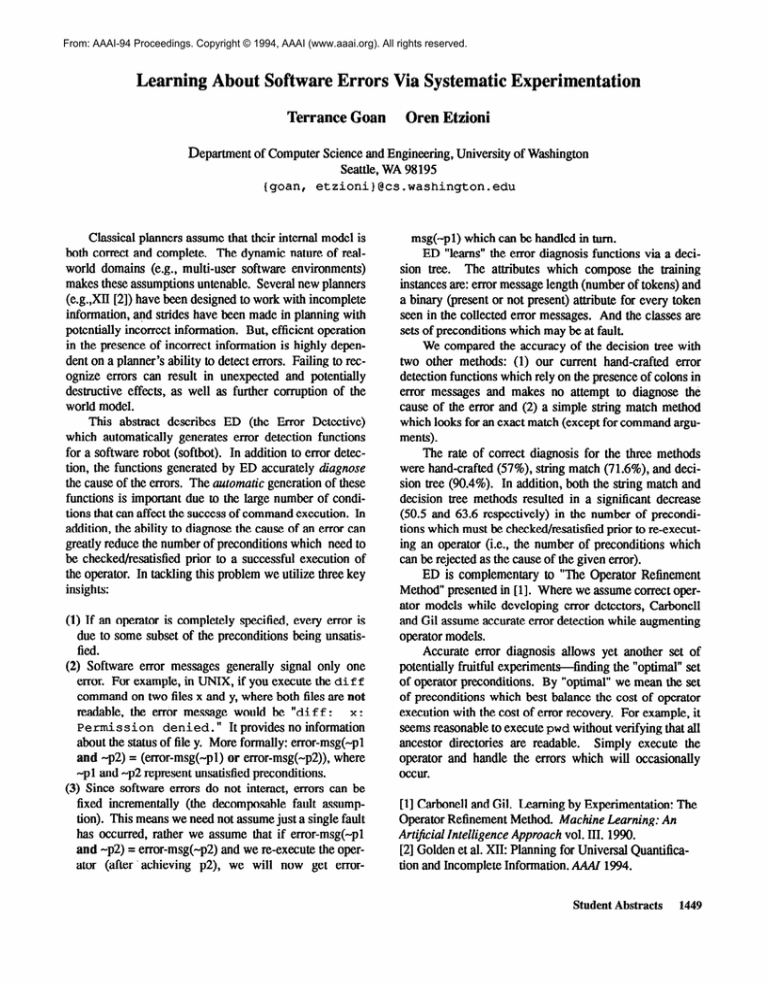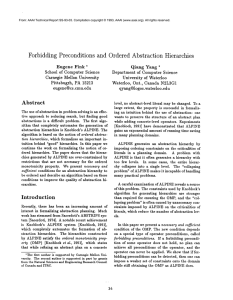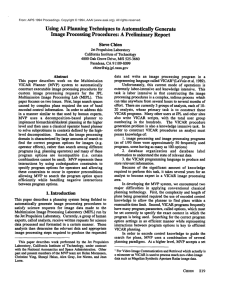
From: AAAI-94 Proceedings. Copyright © 1994, AAAI (www.aaai.org). All rights reserved.
Learning About Software Errors Via Systematic Experimentation
Terrance Goan
Oren Etzioni
Department of Computer Science and Engineering, University of Washington
Seattle, WA 98195
etzioni)@cs.washington.edu
{g-n,
Classical planners assume that their internal model is
both correct and complete. The dynamic nature of realworld domains (e.g., multi-user software environments)
makes these assumptions untenable. Several new planners
(e.g.,XII [2]) have been designed to work with incomplete
information, and strides have been made in planning with
potentially incorrect information. But, efficient operation
in the presence of incorrect information is highly dependent on a planner’s ability to detect errors. Failing to recognize errors can result in unexpected and potentially
destructive effects, as well as further corruption of the
world model.
This abstract describes ED (the Error Detective)
which automatically generates error detection functions
for a software robot (softbot). In addition to error detection, the functions generated by ED accurately diugnose
the cause of the errors. The automatic generation of these
functions is important due to the large number of conditions that can affect the success of command execution. In
addition, the ability to diagnose the cause of an error can
greatly reduce the number of preconditions which need to
be checked,/resatisficd prior to a successful execution of
the operator. In tackling this problem we utilize three key
insights:
(1) If an operator is completely specified, every error is
due to some subset of the preconditions being unsatisfied.
(2) Software error messages generally signal only one
error. For example, in UNIX, if you execute the di f f
command on two files x and y, where both files are not
readable, the error message would be "di f f : x :
Permission
denied." Itprovidesnoinformation
about the status of file y. More formally: error-msg(-pl
and -p2) = (error-msg(-pl) or error-msg(-p2)), where
-pl and -p2 represent unsatisfied preconditions.
(3) Since software errors do not interact, errors can bc
fixed incrementally (the decomposable fault assumption). This means we need not assume just a single fault
has occurred, rather we assume that if error-msg(-pl
and -p2) = error-msg(-p2) and we re-execute the operator (after achieving p2), we will now get error-
msg(-pl) which can be handled in turn.
ED “learns” the error diagnosis functions via a decision tree. The attributes which compose the training
instances are: error message length (number of tokens) and
a binary (present or not present) attribute for every token
seen in the collected error messages. And the classes are
sets of preconditions which may be at fault.
We compared the accuracy of the decision tree with
two other methods: (1) our current hand-crafted error
detection functions which rely on the presence of colons in
error messages and makes no attempt to diagnose the
cause of the error and (2) a simple string match method
which looks for an exact match (except for command arguments).
The rate of correct diagnosis for the three methods
were hand-crafted (57%), string match (71.6%), and decision tree (90.4%). In addition, both the string match and
decision tree methods resulted in a significant decrease
(50.5 and 63.6 respectively) in the number of preconditions which must be checked/resatisfied prior to re-executing an operator (i.e., the number of preconditions which
can be rejected as the cause of the given error).
ED is complementary to “The Qperator Refinement
Method” presented in [l]. Where we assume correct operator models while developing error detectors, Carbonell
and Gil assume accurate error detection while augmenting
operator models.
Accurate error diagnosis allows yet another set of
potentially fruitful experiments-finding the “optimal” set
of operator preconditions. By “optimal” we mean the set
of preconditions which best balance the cost of operator
execution with the cost of error recovery. For example, it
seems reasonable to execute pwd without verifying that all
ancestor directories are readable. Simply execute the
operator and handle the errors which will occasionally
OCCUT.
[l] Carbonell and Gil. Learning by Experimentation: The
Operator Refinement IvIethod. Machine Learning: An
Artificial Intelligence Approach vol. III. 1990.
[2] Golden et al. XII: Planning for Universal Quantification and Incomplete Information. AAAI 1994.
Student Abstracts
1449







